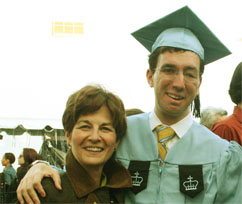
Photos and text used with permission of
Barbara Franklin.
In 1993, we were in the car when Adam said, “Look, Mom, my finger is twitching!”
After consultation with a pediatric neurologist, he, suspecting epilepsy, told us to go to the emergency room where he would admit Adam.
Ten days later, Adam left the hospital with a misdiagnosis of Tuberous Sclerosis.
Two years later, in a routine eye exam, Adam’s doctor saw something of concern and ordered an MRI. And the neurologist, who called me at 11 pm to give me the earth-shattering new diagnosis of Neurofibromatosis Type 2 (NF2), told me my role as a mother was to make Adam comfortable in his couple of remaining years. That was 17 years ago.
When Adam was diagnosed I felt so powerless – that there was nothing I could do. But the truth is there is.
“Way back in the 90’s” when we still used the telephone, I reached out to Dr. Judah Folkman, the doctor who discovered the concept that tumor growth is supported by a robust blood supply and blocking that may cause tumor shrinkage. Dr. Folkman very much believed that many different tumor types would benefit from this concept. He and I shared many phone calls and cups of coffee discussing this uphill battle to convince scientists of this concept. And here we are now using Avastin, and other antiangiogenic drugs on NF2.
I know I will not cure NF2 – but I understand what my role is – first and foremost as Adam’s advocate – always looking for new treatments and concepts – as well as double-checking anything that is proposed for him.
But equally important is to be out there challenging the old ways of thinking. I read everything I can get my hands on – whether directly or indirectly about NF2, be it brain tumors, signaling pathways, holistic concepts of treatment, or new equipment used in other diseases. I think my “contribution” if I dare elevate it to such, is to try to creatively see if any of this applies to NF2 – and then find and challenge researchers to consider them. It wasn’t so long ago that there were no treatments to consider – but now doctors are using drugs once thought to be limited to treating malignant tumors on benign and more importantly, NF2 tumors.
I have worked to raise money for specific NF2 researchers’ concepts, as well as through a family foundation we started at the Children’s Tumor Foundation. I am on the Board of Directors of Advocure, an advocacy group devoted to accelerating research to cure NF2. I have been a Consumer Advocate and sat on the Integration Panel for the CDMRP Program. And I go to Washington, DC to meet with our representatives to discuss the importance of backing funding of the Neurofibromatosis Program of the CDMRP.
The first time I was a consumer advocate I was scared and intimidated. To sit amongst these scientists and give my thoughts on this research? Very quickly I was made comfortable that my contributions were respected and well-regarded. Consumer Advocates bring a unique perspective, whether it is as a person with NF or as a family member. Frequently we are thanked by the scientists who say our stories remind them why they’re in the lab and why it is urgent to accomplish their goals quickly. Listening to their thoughtful analyses of the proposals assure me that the best science is awarded each year.
Last year, I sat on the Integration Panel for CDMRP and watched that final step of selecting the highest scoring proposals that could be funded within the Neurofibromatosis budget. Scientists and foundation members tell me this is the single most important source of funding for Neurofibromatosis. That’s true. But equally important is it encourages out-of-the-box proposals – and as I have seen in the almost 20 years I have been involved with this disease – that can be the fastest way to a cure. I am proud to be a participant in this incredible program, and am devoted to ensuring its continuance until a cure can be found.
Last updated Thursday, May 26, 2022














